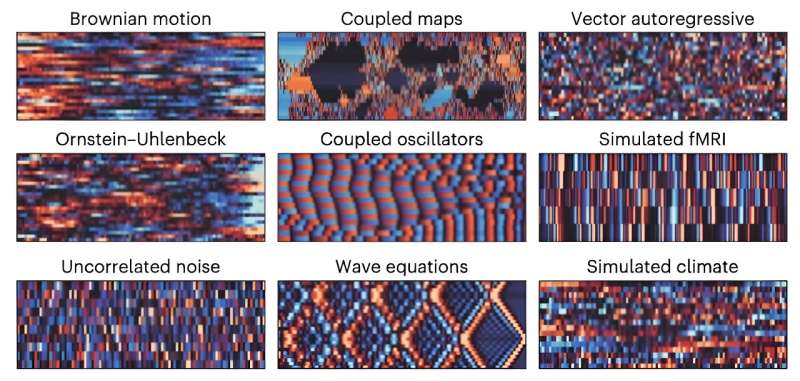This article has been reviewed according to Science X's editorial process and policies. Editors have highlighted the following attributes while ensuring the content's credibility:
fact-checked
peer-reviewed publication
trusted source
written by researcher(s)
proofread
From stock markets to brain scans, new research harmonizes hundreds of scientific methods to understand complex systems

Complexity is all around us, from the daily fluctuations of financial markets to the intricate web of neurons in our brains.
Understanding how the different components of these systems interact with each other is a fundamental challenge for scientists trying to predict their behavior. Piecing together these interactions is like deciphering a code from an intricate set of clues.
Scientists have developed hundreds of different methods for doing this, from engineers studying noisy radio channels to neuroscientists studying firing patterns in networks of interacting neurons. Each method captures a unique aspect of the interactions within a complex system—but how do we know which method is right for any given system sitting right in front of us?
In new research published in Nature Computational Science, we have developed a unified way to look at hundreds of different methods for measuring interaction patterns in complex systems—and working out which ones are most useful for understanding a given system.
A scientific orchestra
The science of complex systems can be, well, complex. And the science of comparing and combining different ways of studying these systems even more so.
But one way to think about what we've done is to imagine each scientific method is a different musical instrument playing in a scientific orchestra. Different instruments are playing different melodies with different tones and in different styles.
We wanted to understand which of our scientific instruments are best suited to solving which types of problems. We also wanted to know whether we could conduct all of the instruments to form a harmonious whole.
By presenting these methods as a full orchestra for the first time, we hoped we would find new ways of deciphering patterns in the world around us.
Hundreds of methods, more than 1,000 datasets
To develop our orchestra, we undertook the mammoth task of analyzing more than 200 methods for computing interactions from as many datasets as we could get our hands on. These covered a huge range of subjects, from stock markets and climate to brain activity and earthquakes to river flow and heart beats.

In total, we applied our 237 methods to more than 1,000 datasets. By analyzing how these methods behave when applied to such diverse scientific systems, we found a way for them to "play in harmony" for the first time.
In the same way that instruments in an orchestra are usually organized as strings, brass, woodwind and percussion, scientific methods from areas like engineering, statistics and biophysics also have their traditional groupings.
But when we organized our scientific orchestra, we found that the scientific instruments grouped together in a strikingly different way to this traditional organization. Some very different methods behaved in surprisingly similar ways to one another.
This was a bit like discovering that the tuba player's melody was surprisingly similar to that of the flute, but no one had noticed it before.
Our weird and wonderful new orchestral layout (which sometimes places cello and trumpet players next to the piccolo player), represents a more "natural" way of grouping methods from all across science. This opens exciting new avenues for cross-disciplinary research.
The orchestra in the real world
We also put our full scientific orchestra to work on some real-world problems to see how it would work. One of these problems was using motion data from a smartwatch to classify activities like "badminton playing" and "running"; another was distinguishing different activities from brain-scan data.
Properly orchestrated, the full ensemble of scientific methods demonstrated improved performance over any single method on its own.
To put it another way, virtuosic solos are not always the best approach! You can get better results when different scientific methods work cooperatively as an ensemble.
The scientific ensemble introduced in this work provides a deeper understanding of the interacting systems that shape our complex world. And its implications are widespread—from understanding how brain communication patterns break down in disease, to developing improved detection algorithms for smartwatch sensor data.
Time will tell what new music scientists will make as they step up to conduct our new scientific orchestra that simultaneously incorporates diverse ways of thinking about the world.
More information: Oliver M. Cliff et al, Unifying pairwise interactions in complex dynamics, Nature Computational Science (2023). DOI: 10.1038/s43588-023-00519-x , www.nature.com/articles/s43588-023-00519-x . On arXiv: DOI: 10.48550/arxiv.2201.11941
This article is republished from The Conversation under a Creative Commons license. Read the original article.![]()





















